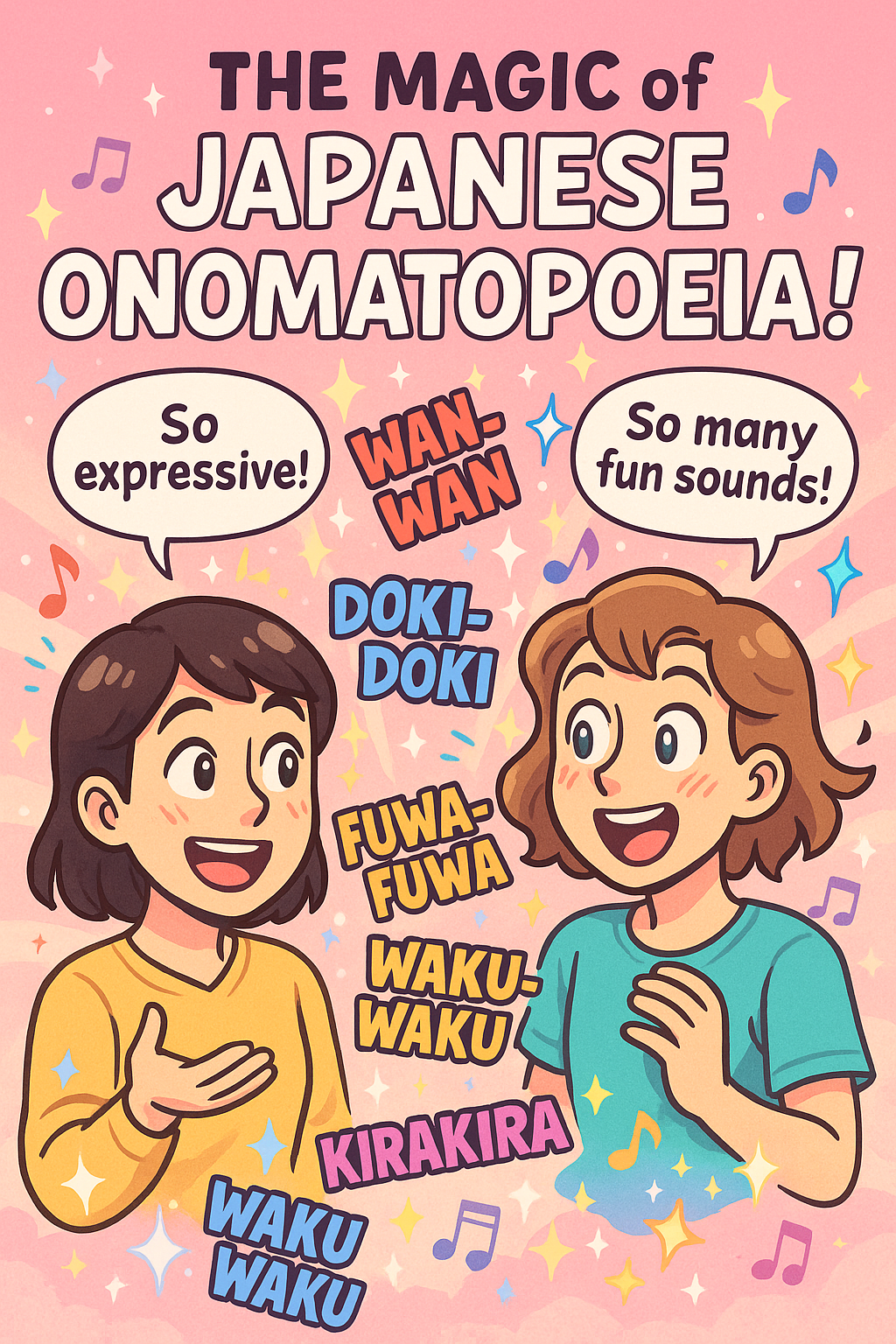
はじめに / Introduction
日本語のオノマトペ(擬音語・擬態語)は、世界でも珍しいほど多彩で奥深い表現です。
「オノマトペ」とは、音や状態、感情、動きなどを、そのまま音にして表現する言葉の総称です。
日常会話、小説、漫画、アニメ、広告、子ども向け絵本など、あらゆる場面で使われています。
オノマトペを知ることで、日本語の世界がぐっとカラフルに広がります。
Japanese onomatopoeia (giongo and gitaigo) is an exceptionally rich and unique system of expression—even compared to other languages.
"Onomatopoeia" refers to words that imitate sounds, states, feelings, and actions. They can be heard everywhere: in daily conversation, novels, manga, anime, commercials, and children’s books.
Understanding onomatopoeia will make your experience of Japanese much more colorful and vivid.
擬音語と擬態語の違い / The Difference: Giongo and Gitaigo
オノマトペは大きく「擬音語(giongo)」と「擬態語(gitaigo)」に分けられます。
擬音語は実際の音をまねた言葉です。
例:
・「ワンワン」(犬の鳴き声)
・「ザーザー」(雨の音)
・「ドンドン」(太鼓の音や物が落ちる音)
擬態語は、音のない状態・感情・動作などを音として表現した言葉です。
例:
・「ふわふわ」(雲やクッションの柔らかい感じ)
・「きらきら」(光る様子)
・「ワクワク」(楽しみで心がはずむ様子)
・「もやもや」(頭や気持ちがすっきりしない感じ)
Japanese onomatopoeia is divided into two main categories: giongo and gitaigo.
Giongo are words that imitate real sounds.
Examples:
・"wan-wan" (the sound of a dog barking)
・"zaa-zaa" (the sound of heavy rain)
・"don-don" (the sound of drums or something dropping)
Gitaigo are words that describe states, feelings, or movements, even when there is no actual sound.
Examples:
・"fuwa-fuwa" (the soft, fluffy feeling of clouds or a cushion)
・"kira-kira" (something shining or sparkling)
・"waku-waku" (the feeling of excited anticipation)
・"moya-moya" (a foggy or unclear feeling, mentally or emotionally)
バリエーション豊かなオノマトペ / A World of Variety
日本語のオノマトペは、動物・天気・体の動き・食べ物の食感・感情など、ありとあらゆる分野で使われます。
・「ぴょんぴょん」(うさぎが跳ねる様子)
・「にこにこ」(笑顔の表情)
・「がぶがぶ」(勢いよく飲む)
・「しーん」(静まり返った静けさ)
・「ぱくぱく」(次々に食べる)
また、「同じ音を繰り返す」形が多く、リズム感や親しみやすさがあります。
Japanese onomatopoeia covers nearly every aspect of life: animals, weather, movement, food texture, and emotions.
・"pyon-pyon" (the hopping of a rabbit)
・"niko-niko" (smiling or a happy face)
・"gabu-gabu" (drinking quickly or greedily)
・"shiiin" (total silence)
・"paku-paku" (eating mouthful after mouthful)
Most onomatopoeic words are made by repeating the same sound, giving a rhythmic and friendly feeling.
会話の中のオノマトペ / Onomatopoeia in Real Conversation
オノマトペは日本語の日常会話でとてもよく使われます。
会話例:
A: 週末どうだった?
B: のんびりゴロゴロしてたよ。
A: いいね~。外はザーザー雨だったしね。
こんなふうに、オノマトペを使うことで、雰囲気や情景がより生き生きと伝わります。
Onomatopoeia is used all the time in everyday Japanese conversation.
Sample Dialogue:
A: How was your weekend?
B: I just relaxed and “goro-goro” (lounged around).
A: Sounds nice! It was “zaa-zaa” (pouring rain) outside anyway.
Using onomatopoeia like this helps bring feelings and scenes to life.
オノマトペで感情やニュアンスを表現 / Expressing Feelings & Nuance
英語では表現しづらい細かな感情や状態も、日本語のオノマトペなら一言で伝わります。
・「いらいら」(イライラする=イライラしている)
・「ドキドキ」(心臓が高鳴る/緊張やワクワク)
・「しっとり」(しっとりしたケーキ=moist cake)
・「キリキリ」(お腹が痛む様子)
英語で説明するには長いフレーズが必要でも、日本語では直感的で便利です。
Japanese onomatopoeia allows you to express delicate feelings or states that would take a long phrase in English.
・"ira-ira" (feeling annoyed or irritated)
・"doki-doki" (heartbeat racing, nervous or excited)
・"shittori" (moist, e.g., a cake)
・"kiri-kiri" (sharp, piercing stomach pain)
It’s quick, intuitive, and very convenient for native speakers.
オノマトペと日本文化 / Cultural Insights
日本語のオノマトペは、子どもから大人まで使います。
漫画やアニメでは、背景や効果音として頻繁に登場しますし、広告や商品名にも多用されています。
たとえば「さらさらシャンプー」や「もちもちパン」など、商品の魅力を一言で表現するのにもぴったりです。
また、日本語の美意識や細やかさ、観察力もオノマトペから感じることができます。
Onomatopoeia is used by everyone in Japan, from children to adults. In manga and anime, these words are used in the background and as sound effects. They’re common in ads and product names too—for example, "sara-sara shampoo" (smooth shampoo) or "mochi-mochi bread" (soft and chewy bread). Onomatopoeia reflects the Japanese appreciation for subtlety, detail, and observation.
学習のコツ・楽しみ方 / Tips for Learning & Enjoyment
オノマトペは覚えにくそうに思えるかもしれませんが、マンガや日常会話、テレビなどで耳にしたり目にしたりするうちに、自然と身につきます。
「同じ音の繰り返し」「動作や音とセットで覚える」などのコツを活用して、楽しくチャレンジしましょう。
好きなマンガの中のオノマトペを集めてみるのもオススメです。
Onomatopoeia might seem tricky to memorize at first, but as you see or hear them in manga, daily conversation, or TV, you’ll naturally get used to them.
Try remembering them by associating them with sounds or actions, and notice the repeating patterns.
It can also be fun to collect your favorite onomatopoeia from manga you enjoy!
まとめ / Conclusion
オノマトペは、日本語の奥深さと楽しさを味わえる、まさに「魔法のことば」です。
たくさんのオノマトペを知って使いこなせば、日本語コミュニケーションの幅が一気に広がります。
ぜひ、日々の会話や読書、アニメなどを通して、オノマトペの世界に触れてみてください!
Onomatopoeia is truly a "magic word" that lets you feel the depth and fun of Japanese.
The more you learn and use onomatopoeia, the richer your Japanese communication will become.
So jump in and enjoy the world of onomatopoeia—through conversation, reading, and anime!